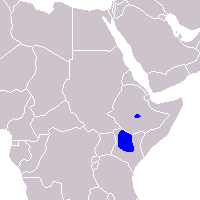
Grévy's zebra (Equus grevyi), Photo: Michael Lahanas
The Grévy's zebra (Equus grevyi), sometimes known as the Imperial zebra, is the largest species of zebra. It is found in the wild in Kenya and Ethiopia. Compared to other zebras, it is tall, has large ears, and its stripes are narrower. In fact, the Grévy's Zebra isn't much of a zebra at all - its DNA is more similar to that of a horse. The species is named after Jules Grévy, a president of France, who, in the 1880s, was given one by the government of Abyssinia. In certain regions of Kenya, the plains zebras and Grévy's zebras coexist. The Grévy's zebra was the first zebra to be discovered by the Europeans and was used by the ancient Romans in circuses. Later, it was largely forgotten about in the Western world until the seventeenth century. Taxonomy The Grévy's zebra differs from the other two zebras in its primitive characteristics and different behaviour. It was the first zebra to emerge as a species. All members of the family are of the genus Equus, but the genus is commonly subdivided into four subgenera; Equus, Asinus, Hippotigris and Dolichohippus. The Plains zebra and Mountain zebra belong to Hippotigris, but the Grévy's zebra is the sole species of Dolichohippus. In many respects, it is more akin to the asses. Nevertheless, DNA and molecular data show that zebras do indeed have monophyletic origins. Physical description Grévy's zebra is the largest of all wild equines. It is 2.5-2.75 m (8-9 ft) from head to tail with a 38-75 cm (15-30 in) tail, and stands 1.45-1.6 m (4'7"-5'3") high at the shoulder. These zebras weigh 350-450 kg (770-990 lb). The stripes are narrow and close-set, being broader on the neck, and they extend to the hooves. The belly and the area around the base of the tail lack stripes. With all of the stripes closer together and thinner than most of the other zebras, it is easier to make a good escape and to hide from predators. The ears are very large, rounded, and conical. The head is large, long, and narrow, particularly mule-like in appearance. The mane is tall and erect; juveniles having a mane extending the length of the back. Grévy's zebra feed mostly on grasses but they will also eat fruit, shrubs and bark. They may spend 60-80% of their days eating, depending on the availability of food. Their well adapted digestive system allows them to subsist on diets of lower nutritional quality than that necessary for herbivores. Also, Grévy's zebras require less water than other zebras.
Grévy's zebra (Equus grevyi), Photo: Michael Lahanas Lifestyle Grévy's zebra is similar to the donkey in many ways. Behaviourally, for example, it has a social system characterised by small groups of adults associated for short time periods of a few months. Adult males spend their time mostly alone in territories of 2-12 km², which is considerably smaller than the territories of the wild asses. The social structure of the Grévy's zebra is well-adapted for the dry and arid scrubland and plains that it primarily inhabits, less for the more lush habitats used by the other zebras. It communicates over long distances. The territories are marked by dung piles and females who wander within the territory mate solely with the resident male. Small bachelor herds are known. Like all zebras and asses, males fight amongst themselves over territory and females. The species is vocal during fights (an asinine characteristic), braying loudly. However unlike other zebras, territory holding Grévy's zebra males will tolerate other males who wander in their territory possibly because non-resident males do not try to mate with the resident male's females nor interfere in his breeding activities. Reproduction Grévy's zebras mate year-round. Gestation of the zebra lasts 350-400 days, with a single foal being born. A newborn zebra will follow anything that moves and thus new mothers are highly aggressive towards other mares a few hours after they give birth. This prevents the foal from imprinting another female as its mother. To adapt to an arid lifestyle, Grévy's zebra foals take longer intervals between suckling bouts and do not drink water until they are 3 months old. They also reach independence from the mare sooner than other equids. Status The Grévy's zebra is considered endangered, partly due to hunting for its skin, which fetches a high price on the world market. Its also suffers habitat destruction, human disturbances at water holes and competition with domestic grazing animals. There are estimated to be 1,500 - 2,000 Grévy's zebra still living in the wild. They are, however, common in captivity. References * Prothero D.R, Schoch R. M, 2003, Horns, Tusks, and Flippers: The Evolution of Hoofed Mammals, The Johns Hopkins University Press External links
Retrieved from "http://en.wikipedia.org/" |
|



